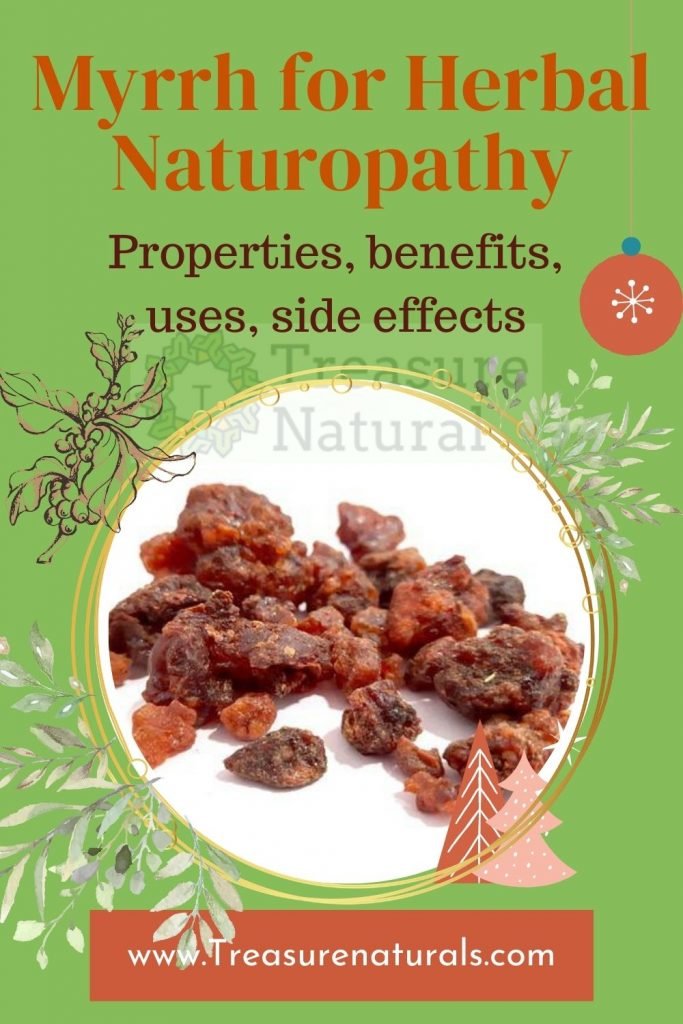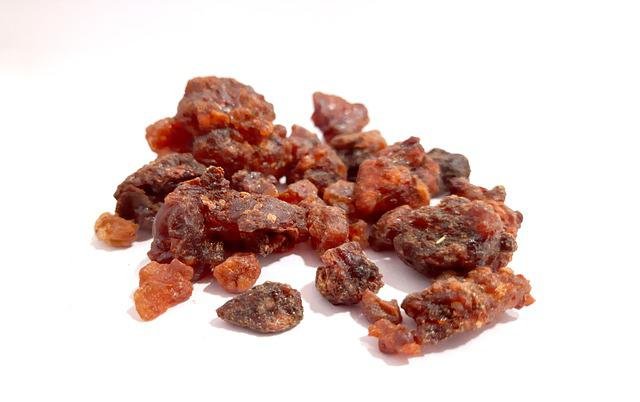
Myrrh is an oleogommoresin isolated from various shrubs or small trees native to Northeast Africa and Southwest Asia. Myrrh exhibits several properties, notably astringent on mucous membranes and antimicrobial. Let’s find out better.
Where is myrrh found
The bark of trees of the genus Commiphora has cavities from which a pale yellow exudate emerges, which soon hardens to form red-yellowish or reddish-brown tears or masses. The drug is represented by these exudates and is called myrrh.
The trees or shrubs that supply this drug are diverse, the best known being Commiohora myrrha (Nees) Engl. and Commiphora mukul (Hook ex Stocks) Engl., the latter known as guggul.
The history of myrrh is ancient: already known in Ancient Egypt for the practice of embalming; it is found in various passages of the Bible, it is one of the main components of the holy oil for anointing, as well as a perfume mentioned seven times in the Song of Songs; in the Gospel of Matthew it was one of the gifts brought by the Magi to the Child Jesus.
In ancient Greece myrrh was widely used and a mythological episode tells of its origin linking it to Myrrh, daughter of the king of Cyprus and mother of Adonis.
It was introduced into Chinese medicine in the 7th century and has been used ever since to treat ailments such as bleeding, pain and wounds.
Myrrh contains 1.5-1.7% of a volatile oil; up to 40% of resins and about 60% of rubber made up of different sugars.
Properties of myrrh
Speaking of myrrh immediately refers us to the homonymous tree Commiphora myrrha (Nees) Engl., Actually there are different trees that produce myrrh, each with characteristic properties.
In general, all the myrrh resins produced show astringent and antimicrobial properties on the mucous membranes , thanks also to the volatile oil composed of erabolene, limonene, dipeptene, pinene, eugenol, cinnamaldehyde, cuminaldehyde and more.
Commiphora myrrha ( Nees) Engl., In particular, is the best application for the treatment of gingivitis, pharyngitis and tonsillitis. It is present in many products used for diseases of the respiratory tract and in mouthwashes.
Furthermore, it has a specific anti-inflammatory and analgesic activity, enhanced by the association with Boswellia extracts. The analgesic action is made possible by sesquiterpenes capable of activating opioid receptors.
Myrrh is also considered non-irritating, non-sensitizing, and free of photosensitivity. Furthermore, Z-guggulsterone, isolated from the essential oil of the oleogommoresin of Commiphora mukul (Hook ex Stocks) Engl., One of the most important drugs of Ayurveda medicine, shows an interesting thyroid stimulating activity.
In addition to acting on the thyroid level, it also stimulates the liver to metabolize LDL cholesterol, the so-called “bad” cholesterol: it reduces VLDL, LDL and triglycerides, while increasing the HDL value, in this way it also acts on the reduction of risk from atherosclerotic plaques.
Furthermore, the phytocomplex of guggul acts in the treatment of other diseases such as obesity , thanks to its stimulating actions on the thyroid gland and reducing lipid metabolism, as well as improving digestion and general metabolism.
Myrrh is mainly used as a tincture and fluid extract, but also in powder, dry extract, oil and in ointments for external use in the case of chapped lips, wounds, ulcerations, hemorrhoids.
Contraindications of myrrh

Myrrh in general is a well tolerated drug.
Guggul, in predisposed subjects can give mild adverse events, such as skin rash, nausea, diarrhea, vomiting, headache, fatigue, apprehension, belching, hiccups. In general, careful use is recommended in people with liver or gastrointestinal disorders. Guggulipid can reduce intestinal absorption of concomitant medications.
As for the myrrh extracted from Commiphora myrrha (Nees) Engl., This is the subject of a specific therapeutic monograph, which positively evaluates its use for the treatment of mild inflammatory states of the mucous membrane of the mouth and pharynx. The Commission itself does not report side effects, contraindications or drug interactions.






